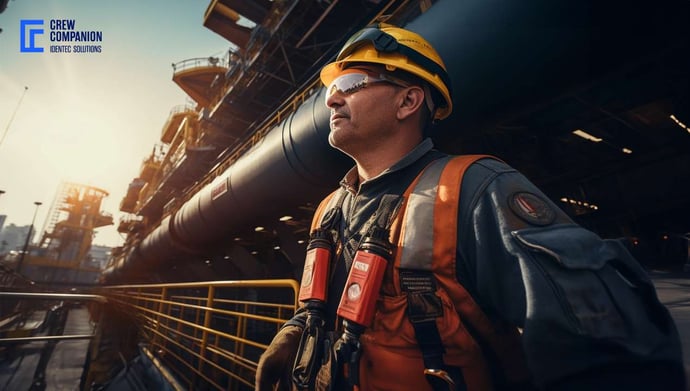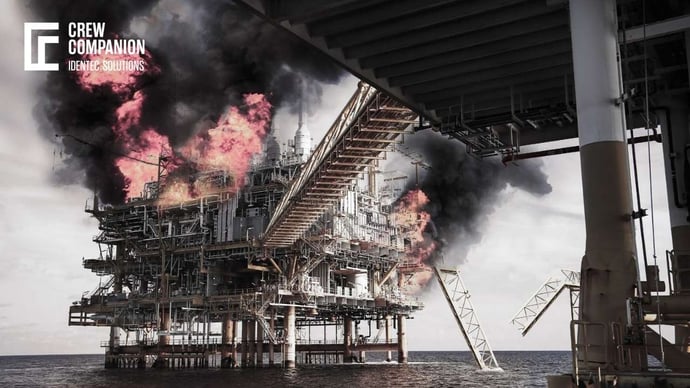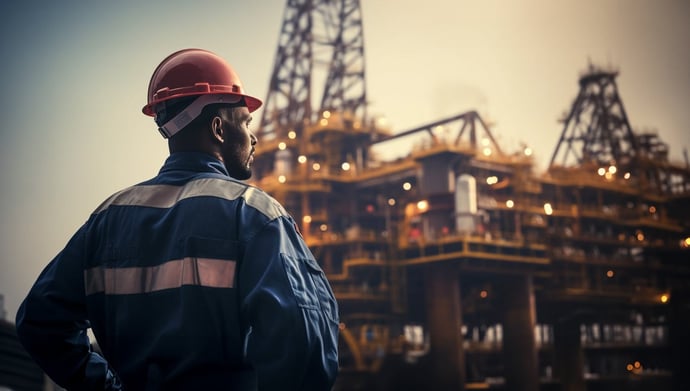Emergency Response Notification System and How to Use It Efficiently
| Written by Michal Wozniakowski-Zehenter

No video selected
Select a video type in the sidebar.
The Nature of Emergencies
Before going into the details of those systems, it's important to understand the types of emergencies that can happen in the offshore environment. Fires or explosions due to flammable materials, gas leaks or releases, severe weather conditions like hurricanes and storms, structural failures from corrosion or poor maintenance, medical emergencies, man overboard incidents where crew members fall into the ocean – the list is unfortunately long, and there are more things that can go south. Because offshore installations are so remote, effective and immediate emergency response notification is essential (see also: HSE standards in the North Sea).
Emergency Response Notification Technologies
An effective system typically comprises several integrated technologies working together to ensure timely communication and proper response.
The Public Address and General Alarm, commonly known as PA or GA, system is crucial for emergency notifications on offshore installations. It broadcasts messages across the platform or vessel using high-quality speakers placed throughout, ensuring audibility even in noisy areas. Emergency messages override other communications, guaranteeing immediate reception by the crew. Different alarms signal various emergencies, and the intercom allows two-way communication between the control room and specific locations. Amplifiers keep audio signals strong and clear, while the speakers are designed to endure tough offshore conditions. Operators control messages and alarms from a central console. The Emergency Broadcast System (EBS), sometimes called the Emergency Action Notification System (EANS) works with the PA/GA system by providing specific frequencies for emergency communication. Crew members can directly communicate with the control room or bridge using two-way radios, while radio paging sends instructions to individuals or groups via personal radios. Satellite communication ensures connection during severe weather, and frequency management prevents interference during emergencies. Handheld radios, base stations, and repeaters improve the range and reliability of communication.
Modern offshore installations use integrated alarm management systems to centralize monitoring and response. These systems collect data from fire alarms, gas detectors, and other safety devices, triggering automated alerts based on predefined emergencies and recording incidents for later analysis. Programmable Logic Controllers - industrial computers with various inputs and outputs, automate responses and data collection, while Human-Machine Interfaces give operators visual data on alarms. Alarm rationalization software prioritizes critical alarms to reduce alarm fatigue. Visual notification systems also play their part in noisy environments – especially FPSOs and oil rigs, but SOVs are definitely not excluded from the party. Strobe lights, digital signage, and escape route indicators help guide crew members to safety. Explosion-proof strobes work safely in hazardous areas, dynamic signage displays location-specific evacuation instructions, and fibre optic pathway lighting creates well-lit escape routes.
Crew notification and monitoring systems are essential for individual safety and accountability. Personal Locator Beacons send distress signals via GPS, and Man Overboard systems automatically trigger alarms if someone falls overboard. Crew management software tracks personnel during evacuations with personal tags. GPS tracking, RFID/NFC tags, and Bluetooth low-energy technology ensure seamless communication and monitoring. Remote monitoring and control systems provide continuous supervision and management, even if control rooms are inaccessible. Authorized personnel can securely access control systems remotely, and satellite connectivity keeps data links active. Virtual control rooms recreate the control room environment for full operational control. VPNs, redundant servers, and cloud platforms guarantee secure communication and data availability.
Muster station management systems keep track of personnel during emergencies (learn more about offshore emergency response from this interview with Jake van den Dries). They use RFID, NFC, or biometric systems for automatic crew counting, while muster station panels show the number of present vs. expected crew members. Real-time updates alert the control room about missing or injured crew. RFID/NFC readers and mobile devices ensure accurate identification and updates. Emergency management software platforms bring together these technologies for comprehensive planning, response, and analysis. They simplify emergency workflows with incident management, track resources like evacuation vessels, firefighting equipment, and medical supplies, and help organize emergency drills. After emergencies, data analysis highlights areas for improvement. Geographic Information Systems, machine learning, and mobile apps help map emergencies, predict incidents, and provide real-time updates.
The Future of Emergency Response Notification Systems
Technological advancements are improving the emergency response offshore. Artificial Intelligence (AI) and Machine Learning (ML) are changing offshore safety management by using predictive analytics to provide useful insights based on past and current data. AI algorithms gather information from various sources, such as sensors, monitoring devices, historical incident records, and environmental factors like weather patterns and ocean currents. Machine learning models analyze this data to find patterns and connections that could indicate possible emergencies. If such patterns are found, alerts are sent to the crew, suggesting actions to prevent accidents or reduce their impact. One practical example is predicting equipment failure. Machine learning models trained on historical maintenance data can identify patterns leading to equipment failure. If such a pattern is detected, the system alerts the maintenance team to prevent potential blowouts or spills. Another example is detecting gas leaks. AI-powered gas detection systems analyze sensor data to spot gas leaks before they reach dangerous levels. The system triggers alarms and notifies the control room if a leak is detected.
The Internet of Things (IoT) technology creates a safety network that closely monitors both crew members and equipment. This network uses sensors and wearable devices, like gas detectors, temperature sensors, and health monitors, to collect data and send it to a central system. Edge computing helps these devices process data locally, allowing for quick alerts and reducing delays. All the data is then gathered in a central system, providing real-time information on crew location, equipment status, and environmental conditions. For example, wearable wristbands track crew members' movement. If something unusual is detected, the control room receives an alert, enabling quick medical help.
View of the Expert
In an interview with Offshore Engineer, Kevin Sligh Sr, the Director of the Bureau of Safety and Environmental Enforcement, discussed how technological innovations in production facilities could emerge from various operational engagements. He explained that these initiatives could range from routine processes like using cameras and devices for vessel or tank inspections, which help avoid confined space hazards, to more complex, non-routine tasks. Such tasks include improving monitoring systems for subsea wells to detect pressure changes signalling potential leaks and tackling specialized projects that require advanced technical skills, like those involving High Pressure – High-Temperature conditions. Sligh also highlighted new technologies designed to manage oil spills, including the Low-Emission Spray Crude Oil Combustor, also known as the BSEE Burner (1).
FAQS
What is an emergency response notification system?
An Emergency Response Notification System is a communication system that quickly informs and guides people during emergencies. It uses different channels to send urgent messages, alerts, and instructions to keep everyone safe. The system detects emergencies using sensors, alarms, or human reporting. Once an emergency is identified, it sends alerts through various channels like text messages, emails, phone calls, mobile apps, desktop alerts, and sirens. It provides instructions for safe evacuation, staying in place, or other actions and coordinates the response with emergency teams. The system also tracks how the response is going and creates reports for evaluation and improvement.
How does the emergency response notification system work in the offshore industry?
In the offshore industry, an Emergency Response Notification System ensures emergency alerts and instructions quickly reach all personnel, whether on rigs, platforms, vessels, or support facilities. The system starts by detecting emergencies using sensors and alarms that can identify fires, gas leaks, or equipment problems. Crew members can also manually report emergencies to the control room. Once an emergency is identified, alerts are sent through various channels like text messages to personal and company-provided mobile phones, emails to key personnel and onshore teams, public address systems, sirens, smart helmets or wristbands, desktop alerts, and push notifications via mobile apps.
The control room coordinates the response, providing instructions on evacuation routes, muster stations, and firefighting actions while activating emergency teams. Real-time monitoring of muster stations, emergency equipment, and environmental conditions ensures everyone is accounted for and safe. Detailed reports are generated afterwards to review the response and identify areas for improvement. The system integrates with other safety systems, like fire detection, gas detection networks, and CCTV surveillance, providing a complete view of the situation. Regular safety drills help ensure crew members are always prepared. Customization and two-way communication are vital. Alerts can be sent to specific groups based on their role, location, and risk level, while a feedback loop allows crew members to confirm receipt of alerts or ask for more help.
TAKEAWAY
Technological advancements are transforming offshore emergency response notification systems, making them more predictive, connected, and user-friendly. Artificial intelligence and machine learning provide predictive analytics, while IoT devices form a comprehensive safety network. Augmented reality improves situational awareness, drones allow rapid damage assessment, and blockchain ensures secure and transparent data management. When combined with traditional emergency response solutions like PA/GA and EBS, these trends create a strong, multifaceted safety network. Future technologies, for instance, 5G, promise even greater sophistication in offshore safety. In this high-risk industry, using these innovations is crucial not just for regulatory compliance but also to ensure the safety and well-being of every crew member. Investing in advanced technologies can create safer offshore environments, saving lives and reducing the impact of emergencies.
Delve deeper into one of our core topics: Emergency Response Management
Sources
(1) https://www.oedigital.com/news/504768-interview-kevin-sligh-sr-director-bsee
Further Reading
https://boatwatch.org/safety-at-sea/understanding-emergency-notification-devices/

Author
Michal Wozniakowski-Zehenter, Marketing Manager
Michal Wozniakowski-Zehenter is an experienced marketing and project management professional. He spent most of his career on projects with a strong focus on digital marketing and event management. He is a very active voice representing offshore and mining industries through social media channels. Michal writes mainly about offshore oil and gas, renewable energy, mining and tunnelling. Compiling and sharing the knowledge within industries is one of his goals.



